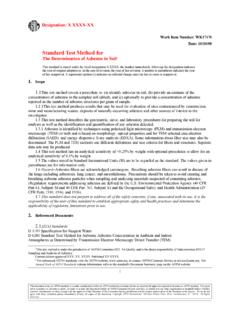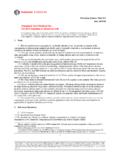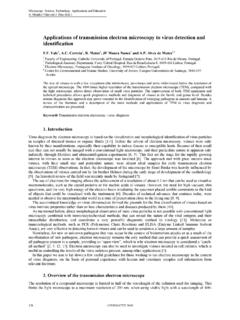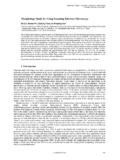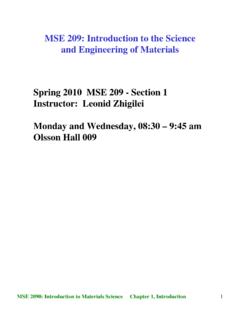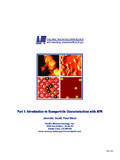Transcription of Research Method for Sampling and Analysis of …
1 Research Method forSampling and Analysis ofFibrous amphibole inVermiculite attic InsulationEPA/600/R-04/004 DISCLAIMER This report was prepared under contract to the Environmental Protection Agency. policies of the Environmental Protection Agency, nor does the mention of trade names or commercial products constitute endorsement or recommendation for use. ACKNOWLEDGMENTS This project was managed under the direction of Roger C. Wilmoth, Program Manager, and Glenn M. Shaul, Project Officer of the EPA Office of Research and Development (ORD) National Risk Management Research Laboratory. This Method was developed using contractor support from Science Applications International Corporation (SAIC) under Contract 68-C-02-067, WA 0-49 and 1-49 with Jo-Ann Saville serving as SAIC s Work Assignment Manager.
2 SAIC utilized sub-contractor support from Research Triangle Institute (RTI) with Michael Beard, RTI, serving as meeting facilitator and primary report writer. Mr. Shaul and Mr. Wilmoth also contributed as authors. A technical panel was convened for this effort consisting of Eric Chatfield, Chatfield Technical Consulting, Ltd., Greg Meeker, United States Geological Survey, USGS, James Millette, MVA Inc., and Jeanne Orr, Reservoirs Environmental, Inc. In addition to the invited panel, a number of representatives from EPA and other government agencies participated in the two day meeting. These included: Lauren Drees, EPA - ORD; Joe Fernback, NIOSH - CDC; Peggy J. Forney, EPA - NEIC; Mary Goldade, EPA - Region 8; Kathleen Meier, EPA - ORD; Aubrey Miller, EPA - Region 8;Paul Peronard, EPA - Region 8; Gigi Salama, EPA - ORD; Greg Sayles, EPA ORD; Glenn Shaul, EPA - ORD; Chon Shoaf, EPA - ORD; Subhas Sikdar, EPA ORD; John H.
3 Smith, EPA - OPPT; Richard Troast, EPA - OERR; Jim Webber, NY State Dept. Of Health; Chris Weis, EPA - NEIC; John Wheeler, CDC - ATSDR; and Roger Wilmoth, EPA - ORD. Meeting support staff consisted of Cat Cole - Court Reporter, Marilyn Joos, EPA - ORD and Phyllis McKenna, EPA - ORD. Cover photo by Glenn M. Shaul, EPA. All other photos by Eric J. Chatfield, Chatfield Technical Consulting, Inc. Such support, however, does not signify that the contents necessarily reflect the views and January 2004 FOREWORD The Environmental Protection Agency (EPA) is charged by Congress with protecting the Nation s land, air, and water resources. Under a mandate of national environmental laws, the Agency strives to formulate and implement actions leading to a compatible balance between human activities and the ability of natural systems to support and nurture life.
4 To meet this mandate, EPA s Research program is providing data and technical support for solving environmental problems today and building a science knowledge base necessary to manage our ecological resources wisely, understand how pollutants affect our health, and prevent or reduce environmental risks in the future. The National Risk Management Research Laboratory (NRMRL) is the Agency s center for investigation of technological and management approaches for preventing and reducing risks from pollution that threaten human health and the environment. The focus of the Laboratory s Research program is on methods and their cost-effectiveness for prevention and control of pollution to air, land, water, and subsurface resources; protection of water quality in public water systems; remediation of contaminated sites, sediments and ground water; prevention and control of indoor air pollution; and restoration of ecosystems.
5 NRMRL collaborates with both public and private sector partners to foster technologies that reduce the cost of compliance and to anticipate emerging problems. NRMRL s Research provides solutions to environmental problems by: developing and promoting technologies that protect and improve the environment; advancing scientific and engineering information to support regulatory and policy decisions; and providing the technical support and information transfer to ensure implementation of environmental regulations and strategies at the national, state, and community levels. This publication has been produced as part of the Laboratory s strategic long-term Research plan. It is published and made available by EPA s Office of Research and Development to assist the user community and to link researchers with their clients.
6 Lee A. Mulkey, Acting Director National Risk Management Research Laboratory TABLE OF CONTENTS 1 INTRODUCTION AND BACKGROUND .. Required Characteristics for an Analytical Method for Determination of fibrous amphibole in vermiculite .. 3 Analytical Considerations Specific to vermiculite from Libby, Montana .. Analytical Considerations for vermiculite Sources Other Than Libby .. Precautions ..42 PRINCIPLE OF Method .. Types of Measurement ..43 SCOPE AND FIELD OF APPLICATION .. Substance determined .. Weight Percent fibrous amphibole .. Concentration of Suspended Particles .. Type of Sample .. Limit of Detection ..74 DEFINITIONS ..85 ABBREVIATIONS ..10 6 EQUIPMENT AND APPARATUS ..11 ..11 Sampling ..11 Sample Preparation ..11 Rapid Screening Method for Sinks Fraction by Stereomicroscopy/PLM.
7 11 Measurement of Sinks and Suspended Particles fractions by SEM/TEM ..12 7 REAGENTS ..12 8 SELECTION AND PRE-TREATMENT OF SAMPLE FOR Analysis ..12 Types of Sample ..12 Obtaining a Representative Sample of VAI ..12 Obtaining a Representative Sub-Sample for Analysis ..13 Pretreatment of Sub-Samples ..14 9 PROCEDURE FOR Analysis ..14 General ..14 Rapid Screening Analysis to Determine the Weight Percent of fibrous amphibole 14 General ..14 Separation of vermiculite from other Components by Flotation on Water 15 Optional Preparation of TEM Specimens From the Aqueous Suspension of vermiculite ..15 Stereo-Binocular Microscope Examination of the Sinks ..15 Determination of Concentration of Suspended fibrous amphibole Particle by Electron Microscopy.
8 19 Introduction ..19 Separation of Suspended Particles ..19 Preparation of TEM Specimens From Displaced Suspension ..19 Examination of TEM Specimens ..22 Examination of SEM Specimens ..22 10 DATA REPORTING ..22 Rapid Screening Analysis for Sinks to Determine Minimum Weight Percent of fibrous amphibole ..22 Concentration of fibrous Amphiboles in the Suspended Particles Fraction ..22 11 ACCURACY AND PRECISION ..23 12 QUALITY ASSURANCE ..23 13 REFERENCES ..24 Appendix A Examples of EDS spectra for Libby amphiboles ..26 1 INTRODUCTION AND BACKGROUND General The purpose of this procedure is to provide the U. S. Environmental Protection Agency s (EPA) Office of Research and Development (ORD) with a Method for the characterization of the fibrous amphibole content of vermiculite attic insulation (VAI).
9 This procedure is to be used in an ORD Research project dealing with determining the airborne levels of fibrous amphiboles in residences where VAI is used. This procedure was developed from input received from fibrous amphibole monitoring experts at an interagency meeting on Analytical Method for Bulk Analysis of vermiculite , held in Greater Cincinnati, Ohio on July 17-18, 2003. This procedure was developed from a Method prepared by Eric J. Chatfield, , Chatfield Technical Consulting, Inc., Mississauga, Ontario, Canada, for Mr. Wayne Toland, Environmental Protection Agency, EPA Region 1, Boston, MA, 02114. The current Method has streamlined the original Method to provide a means for analytical laboratories to determine the presence of fibrous amphiboles in VAI.
10 For Analysis of vermiculite in other materials, the analyst is referred to the original Method by Chatfield, [Chatfield (2000)]. This Method provides an approach to determine the percentage of fibrous amphibole present in VAI. EPA is determining this percentage for purposes of selecting residences to sample during the Research project. EPA does not correlate the percentage of fibrous amphibole , as determined by this Method , with risk or remediation. While the principles of this procedure may be applied to the Analysis of other vermiculite materials, it may be necessary for the user to address any unique characteristics of these alternate materials with appropriate modifications to this procedure. vermiculite is a naturally occurring mineral that has the unusual property of expanding into books or worm-like accordion shaped pieces when heated.

